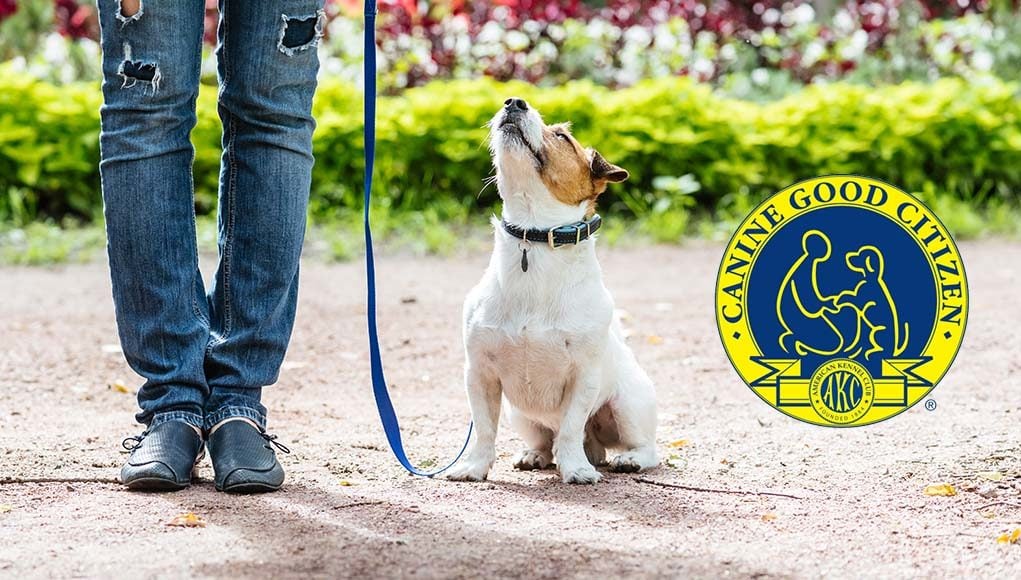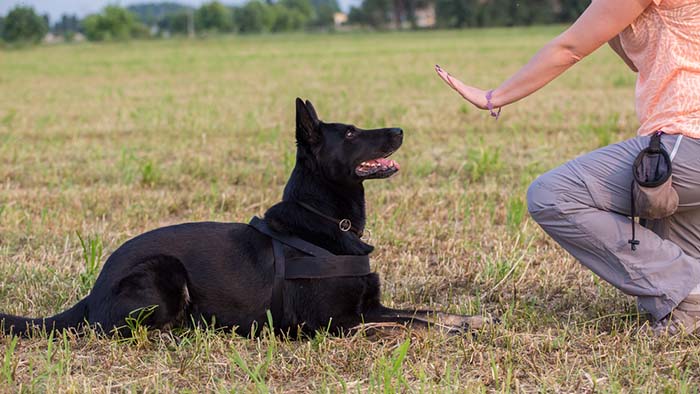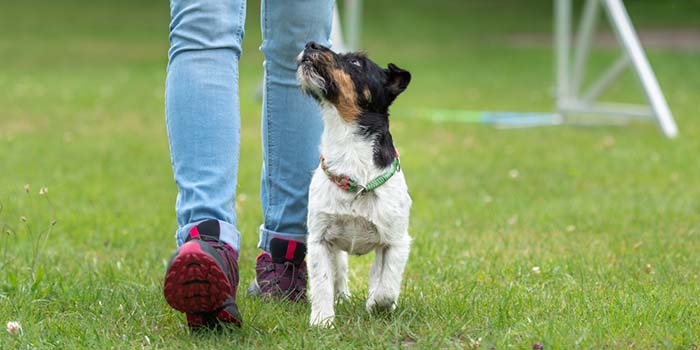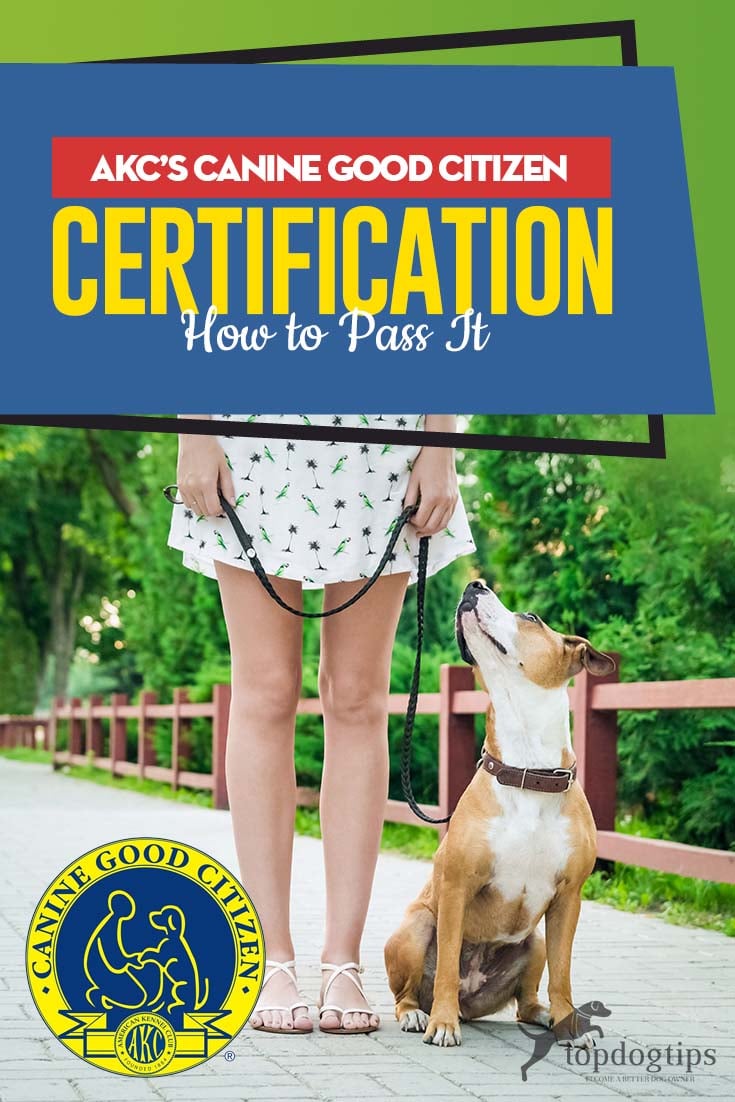The AKC Canine Good Citizen program provides a solid foundation of behavioral training for your dog, but it also comes with some unexpected additional perks. Here's everything you must know about the CGC program from how to get enrolled to some of those perks.
What is the Canine Good Citizen Program?
The Canine Good Citizen program was formally introduced by the American Kennel Club in 1989. Since it’s inception, close to one million dogs have taken part in the CGC behavioral program both as a precursor to more advanced programs and as a behavioral training opportunity.
The skills that your dog will learn in the Canine Good Citizen program are designed to teach them how to behave in a socially acceptable way which is why the program is often referred to as a “class in good manners” for dogs.
Benefits of CGC
There are more than a few benefits to getting your dog CGC trained and tested:
- A better-behaved animal companion.
- A pup with a better ability to communicate with and understand you.
- A stronger bond with you.
- A solid foundation of obedience that can be applied to any other skill or used alone.
- Makes the dog a great ambassador for other dogs in the community.
- CGC training is also a necessary step for many types of “dog jobs”, particularly for dogs who intend to provide therapy dog services.
- Lastly, it makes for a safer environment overall because it gives you a better ability to control the animal in a variety of situations.
Before You Get Into It…
Before you sign up for the AKC's Canine Good Citizen program with your dog, there are a few things that you will need to do.
Find a CGC training class
If you are interested in taking a local CGC training class with your pooch, the best place to look for a referral is your local AKC dog club. Since the CGC is an American Kennel Club program, you will find the most information about local programs through them.
You may also be able to find non-AKC classes that teach the necessary skills for passing the CGC test and another option to explore if you are having a difficult time finding an AKC class to fit your schedule. Just be sure that the class you choose will teach your dog the same skills as those included in the AKC CGC training program (we'll get to those momentarily).
Keep in mind that when you enroll in the AKC CGC class, that class usually incorporates final testing with an approved CGC evaluator into the program. If you take a non-AKC CGC training program, however, it will be up to you to find and arrange for a CGC evaluator to evaluate your dog for the AKC Canine Good Citizenship testing.
Find a CGC evaluator
If you choose to take an alternative training course or teach your dog the CGC skills yourself, you will need to arrange for a Canine Good Citizen evaluator to test your dog after they have mastered their training.
Again, your local AKC breed club is going to be the best place to get referrals for evaluators, but you can also search through the AKC’s directory of approved CGC evaluators. It will be up to you to select an evaluator and arrange for your dog to take the CGC test with them.
Before we get too ahead of ourselves, however, let’s take a look at what the Canine Good Citizen program requires of its students.
10 Focal Points Canine Good Citizen Program
There are ten main points of focus in the Canine Good Citizen program. In order to earn their CGC, your dog must master each task and perform that task when tested by an official AKC CGC certified trainer without failure or dismissal.
Test Point #1: Accepting a Friendly Stranger
The first test point in CGC evaluation tests is whether your dog will allow a friendly stranger to approach and speak with their handler in a normal, everyday type of setting. To do this, the evaluator will walk up to you in a friendly way, paying no attention to your dog. They will then shake your hand and exchange greetings.
To pass this test point: your pet must not display any resentment towards the evaluator.
Test Point #2: Sitting Politely for Petting
The second test point is whether your pup will allow a friendly stranger to touch them while they are with their handler. To do this, you should have your dog sitting beside you and the evaluator will pet your dog on their head and body. You are permitted to talk to your dog during this evaluation and your dog may stand in place to be pet if they prefer.
To pass this test point: same as above, your dog must not display any shyness or resentment towards the evaluator.
Test Point #3: Appearance and Grooming
Third test is whether your dog is welcoming of grooming and examination such as those they may undergo at a groomer or at the veterinarian. This testing point also gives the evaluator time to evaluate the cleanliness and grooming of your pet to be sure that they are healthy.
During this test, you should provide your dog’s usual brush to the evaluator so that they can carefully brush your dog. The examiner will then examine their ears and lift each foot off the ground. You are permitted to talk to your dog during this evaluation and your dog does not have to hold any specific position.
To pass this test point: your dog must be in healthy and presentable condition and they must be tolerant of the evaluator’s examination.
Test Point #4: Out for a Walk (Walking on a Loose Lead)
The fourth test point is whether you are able to control your dog while walking them on a leash. You will begin with your dog at your side and as you walk, your pup should remain engaged with you and follow your movements as desired. Note that the dog does not have to be perfectly in sync with you nor do they have to sit each time you stop; however, if you prefer your dog to sit at each stop, you are welcome to have them do so.
To pass this test point: your dog must remain responsive to you and leave no doubt that they are attentive to you throughout the test.
Test Point #5: Walking Through a Crowd
The fifth test is whether the animal is capable of moving comfortably through pedestrian traffic and is able to walk around and pass closely to others on the street without any signs of over-excitement, resentment or shyness. You may encourage the dog and praise them or simply talk to them throughout this test point.
To pass this test point: your dog must be able to pass close-by to others without tugging against their leash, being rowdy, or attempting to jump on people.
Test Point #6: Sit, Down and Stay on Command
The sixth test point is whether your pooch is able to follow a sit and down command when given and whether they are capable of staying in place. You will begin with your dog by your side in either a “sit” or a “down” position. You must then ask them to perform a “sit” and a “down” command. You will then switch out the leash for a 20-foot long line leash and leave the pet in a stay position (you can have them sit or stay for this command.)
The evaluator will then ask you to give your dog the “stay” command and then walk forward for the full length of the long line leash before turning around to come back again. You must walk naturally and your canine must remain in their “stay” command (although they may switch positions to get more comfortable). If the pet successfully completes their “stay” you will then be instructed to “release” them from the command.
During this test point, you may not force the pup into any positions, but you may gently guide them with your hands.
To pass this test point: your dog must perform the required actions without distraction and must not show any signs of being stubborn. The evaluator must be able to see that the dog is responding to your commands.
Test Point #7: Coming When Called
The seventh test point is whether the Fido will come when called by you. Your evaluator will have you walk 10 feet from the dog before turning around to face them and call them to you. You are allowed to use encouragement to get your pet to come to you and you may also give them a “stay” or “wait” command to instruct them to stay in place.
To pass this test point: your dog must come to you when called but not before.
Test Point #8: Reaction to Another Dog
The eighth one tests the dog’s reaction to other dogs to be sure that they will react in a polite way to other animals they may meet. To do this test, you will be asked to walk towards another student with your pooch while they walk towards you with their dog.
You will begin around 20 feet apart from the other handler and their pet. As you meet the other handler, you will be asked to shake hands with them and exchange greetings before continuing to walk on for another ten feet.
To pass this test point: your dog should have no significant reaction to the other animal aside from a casual interest in them. Your dog should also not go to the other pet or the other handler.
Test Point #9: Reaction to Distraction
The ninth test is for dog’s reaction to distraction to be sure that they can remain cool-headed and confident in day to day situations despite any distraction(s). During this exercise, the evaluator will select and perform two distraction scenarios for your pup and gauge their reaction.
It is permissible for your dog to be interested or curious about the distraction and a slight level of startling is also acceptable. You may talk to and encourage the pet throughout the exercise.
To pass this test point: your dog may not show any signs of panic, aggressiveness, or bark.
Test Point #10: Supervised Separation
The tenth one tests whether the animal can be left alone with a trusted person and maintain acceptable behavior during this period. The evaluator may ask whether you would like them to “watch your dog” before taking over their leash. You will then be asked to go somewhere out of sight for three full minutes. Your pet does not have to stay in a single position during this time and the evaluator may talk to them, too.
To pass this test point: your dog must not show anything other than mild nervousness or agitation; they should not pace, and they should not whine or bark continuously. Additionally, the evaluator must not have to repeatedly try to manage your dog, pet them repeatedly, or talk to them excessively.
AKC Canine Good Citizen Testing
Equipment for Testing
When your Fido takes their CGC test, they must have a leash and collar. The collar must be a leather, fabric, or chain slip collar or a well-fitted buckle collar. You may NOT put a pinch collar, head harness, or electronic collar on your dog for their test.
Dogs are allowed to wear a body harness for their testing; however, the harness must be cleared by the evaluator prior to testing to be sure that it is not restrictive or manipulative of the dog in any way.
You will also be asked to bring your dog’s grooming brush for test point three.
Encouragement During Testing
During your dog’s CGC testing, you are allowed to encourage and praise your pooch and you may also pet them between the different test points. You are NOT permitted to use food, drink, or toys, or to manipulate the animal into performing certain actions.
Reasons for Failure or Dismissal
There are two main reasons for dogs to be dismissed from CGC testing:
- The dog eliminates during the test. This is considered a failure. The only time this may be overlooked is during the tenth test point if it is held in an outdoor forum.
- The dog snaps, growls, bites, attacks, or tries to attack any person or animal. In this instance, the animal will be dismissed from the test.
“AKC CGC Responsible Dog Owners Pledge”
Prior to taking the Canine Good Citizen test with your companion, you will be asked to sign the “AKC CGC Responsible Dog Owner’s Pledge. This pledge is a list of responsibilities that you pledge to uphold as a responsible dog owner and includes the following:
- I will be responsible for my dog’s health needs (routine veterinary care including check-ups and vaccines, adequate nutrition through proper diet, clean water at all times, daily exercise and regular bathing and grooming).
- I will be responsible for my dog’s safety.
- I will properly control my dog by providing fencing where appropriate, not letting my dog run loose, and using a leash in public.
- I will ensure that my dog has some form of identification when appropriate (which may include collar tags, tattoos, or microchip ID).
- I will provide adequate supervision when my dog and children are together.
- I will not allow my dog to infringe on the rights of others.
- I will not allow my dog to run loose in the neighborhood.
- I will not allow my dog to be a nuisance to others by barking while in the yard, in a hotel room, etc.
- I will pick up and properly dispose of my dog’s waste in all public areas (such as on the grounds of hotels, on sidewalks, parks, etc.)
- I will pick up and properly dispose of my dog’s waste in wilderness areas, on hiking trails, campgrounds and in off-leash parks.
- I will be responsible for my dog’s quality of life.
- I understand that basic training is beneficial to all dogs.
- I will give my dog attention and playtime.
- I understand that owning a dog is a commitment in time and caring.
Programs to Consider Afterwards
Once you have completed CGC training and testing, you may find that you miss the level of interaction that the course gave you and the pup. If this is the case, there are plenty of other great classes and opportunities to consider, including:
- AKC Community Canine (CGCA)
- AKC Urban Canine Good Citizen (CGCU)
- AKC Therapy Dog Program
- AKC Trick Dog or General Trick Dog Training
- Dog sports
- Obedience
- Agility
- Rally
- Tracking
- Scent Work
- Performance Events
READ NEXT: 10 Most Common Dog Behavior Problems (and How to Fix Them)
















